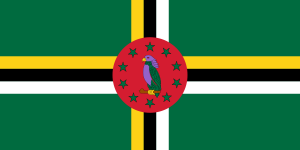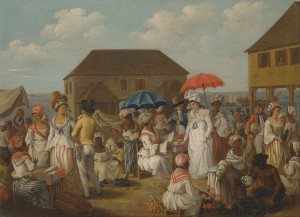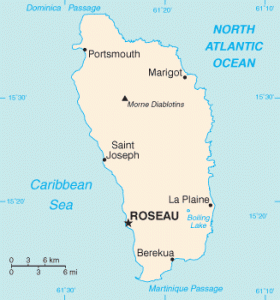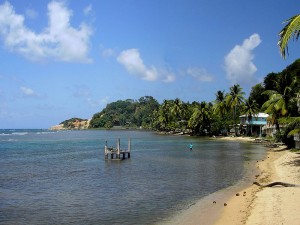Dominica

Kalinago Territory, Dominica, West Indies
Learn of the life of the Carib people. Their practices, culture, history, food, people.
Dominica (/ˌdɒmɪˈniːkə/ dom-i-nee-kə; French: Dominique; Kali‘na (Carib): Wai‘tu kubuli), officially the Commonwealth of Dominica, is an island nation in the Lesser Antilles region of the Caribbean Sea, south-southeast of Guadeloupe and northwest of Martinique. Its size is 750 square kilometres (290 sq mi) and the highest point in the country is Morne Diablotins, which has an elevation of 1,447 metres (4,747 ft). The Commonwealth of Dominica had a population of 71,293 at the 2011 Census. The capital is Roseau which is located on the leeward side of the island.
Dominica has been nicknamed the “Nature Isle of the Caribbean” for its unspoiled natural beauty. It is the youngest island in the Lesser Antilles, still being formed by geothermal–volcanic activity, as evidenced by the world’s second-largest hot spring, Boiling Lake. The island features lush mountainous rainforests, home of many rare plant, animal, and bird species. There are xeric areas in some of the western coastal regions, but heavy rainfall can be expected inland. The Sisserou Parrot (also known as the Imperial Amazon), the island’s national bird, is featured on the national flag. Dominica’s economy is heavily dependent on both tourism and agriculture.
Christopher Columbus named the island after the day of the week on which he spotted it, a Sunday (dominica in Latin), 3 November 1493. In the hundred years after Columbus’s landing, Dominica remained isolated. More Caribs settled there after being driven from surrounding islands, as European powers entered the region. France had a colony for several years, importing African slaves to work on its plantations. In this period, the Antillean Creole language developed. France formally ceded possession of Dominica to Great Britain in 1763. Great Britain established a small colony on the island in 1805.
Britain emancipated slaves occurred throughout the British Empire in 1834. By 1838, Dominica became the first British Caribbean colony to have a legislature controlled by an ethnic African majority. In 1896, the United Kingdom took governmental control of Dominica, turning it into a Crown colony. Half a century later, from 1958 to 1962, Dominica became a province of the short-lived West Indies Federation. On 3 November 1978, Dominica became an independent nation.
Etymology and Languages
The name Dominica comes from the Latin word for Sunday, which was the day on which it was spotted by Christopher Columbus. Its pre-Columbian name by the Caribs was Wai‘tu kubuli, which means “Tall is her body.” The indigenous people of the island were the Caribs.
The island became multi-ethnic due to European colonization, which included the importation of numerous African slaves. The French had the longest influence prior to ceding the island to the British in 1763 after losing the Seven Years’ War. An Antillean Creole, based on the French language, West African and Carib influences, is still spoken by many residents, especially people of older generations.
Today the Carib have some reserved land, known as the Carib Territory, an area similar to the Indian reserves of Canada or the US. The official language is English, following the island’s history since the late 18th century as a British colony, territory, and state. The demonym or adjective is “Dominican” in English. It is pronounced with the syllable stress being on the second “i,” serving to distinguish it from same word used in reference to Dominican Republic, in which case the stress is on the first “i.”
History of Dominica – Early European Contacts
In 1635, France claimed Dominica along with all the other ‘Petite Antilles’ but did not attempt settlement. Between 1642 and 1650 a French missionary Raymond Breton became the first regular European visitor to the island. In 1660 the French and English agreed that both Dominica and St. Vincent should not be settled, but left to the Caribs as neutral territory. Dominica was officially neutral for the next century. Its natural resources attracted rival expeditions of English and French foresters, who began harvesting timber by the start of the 18th century.
French Colony
In 1715, the French established their first permanent settlements in Dominica. With the revolt of “poor white” smallholders in the north of Martinique, known as La Gaoulé, many migrated to southern Dominica. In 1727 the first French commander, M. Le Grand, took charge of the island with a basic French government; Dominica formally became a colony of France, and the island was divided into districts or “quarters.” Already installed in Martinique and Guadeloupe and cultivating sugar cane, the French gradually developed plantations in Dominica for coffee. They imported African slaves to fill the labor demands.
After France was defeated by Britain in the Seven Years’ War, it ceded the island to the British under the Treaty of Paris (1763). In 1778, during the American Revolutionary War, the French mounted a successful invasion with the active cooperation of the population. The 1783 Treaty of Paris, which ended the war, returned the island to Britain. French invasions in 1795 and 1805 ended in failure.
British Colony
 A linen market in 1770’s Dominica
A linen market in 1770’s Dominica
In 1763, the British established a legislative assembly, representing only the whitepopulation. In 1831, reflecting a liberalization of official British racial attitudes, the Brown Privilege Bill conferred political and social rights on free blacks (or people of color). Britain abolished slavery in Dominica and the rest of its empire in 1834. The next year, three men of African descent were elected to the legislative assembly.
In 1838, Dominica became the only British Caribbean colony to have a legislature with a majority of ethnic African members. (Most were of mixed race and had ancestors free before abolition.) Slaves escaped to Dominica from the neighboring islands of Martinique and Guadeloupe, where the French colonies still maintained it. They used makeshift boats, trying to find refuge in Dominica. Most ethnic African legislators were smallholders or merchants, who held economic and social views diametrically opposed to the interests of the small, wealthy English planter class. Reacting to a perceived threat to their power, the planters lobbied for more direct British rule.
In 1865, after much agitation and tension, the colonial office replaced the elective assembly with one that had one-half of members who were elected and one-half who were appointed. Planters allied with colonial administrators outmaneuvered the elected legislators on numerous occasions. In 1871, Dominica became part of the Leeward Island Federation. The power of the ethnic African population progressively eroded. Crown Colony government was re-established in 1896. All political rights for the vast majority of the population were effectively curtailed. Development aid, offered as compensation for disfranchisement, proved to have a negligible effect in improving conditions for most ethnic Africans.
History Post-1900
Following World War I, an upsurge of political consciousness throughout the Caribbean led to the formation of the Representative Government Association. Marshaling public frustration with the lack of a voice in the governing of Dominica, this group won one-third of the popularly elected seats of the legislative assembly in 1924 and one-half in 1936. Shortly thereafter, Dominica was transferred from the Leeward Island Administration.
It was governed as part of the Windwards until 1958, when it joined the short-lived West Indies Federation. After the federation dissolved, Dominica became an associated state of the United Kingdom in 1967 and formally took responsibility for its internal affairs. On 3 November 1978, the Commonwealth of Dominica was granted independence by the United Kingdom.
In mid-1979, political discontent led to the formation of an interim government. It was replaced after the 1980 elections by a government led by the Dominica Freedom Party under Prime Minister Eugenia Charles, the Caribbean’s first female prime minister. Chronic economic problems were compounded by the severe impact of hurricanes in 1979 and in 1980.
In 1981, Dominica was threatened with a takeover by mercenaries led by Mike Perdue of Houston and Wolfgang Droege of Toronto, who tried to overthrow the government of Eugenia Charles. The North America mercenary group was to aid ex-Prime Minister Patrick John and his Dominica Defence Force in regaining control of the island in exchange for control over the island’s future development. The entire plan failed. The ship hired to transport the men of Operation Red Dog never left the dock, as the United States FBI was tipped off. The self-titled mercenaries lacked any formal military experience and/or training, and the majority of the crew had been misled into joining the armed coup by Mike Perdue, considered a con-man ringleader. “White” nationalist Don Black was also jailed for his part in the attempt, which violated US neutrality laws.
By the end of the 1980’s, the economy recovered. It weakened again in the 1990s because of a decrease in banana prices and worldwide recession.
In the January 2000 elections, the Edison James United Workers Party (UWP) was defeated by the Dominican Labour Party (DLP), led by Roosevelt P. “Rosie” Douglas. Douglas died after only a few months in office and was replaced by Pierre Charles, who died in office in January 2004. Roosevelt Skerrit, also of the DLP, replaced Charles as Prime Minister. Under Prime Minister Skerrit’s leadership, the DLP won elections in May 2005 that gave the party 12 seats in the 21-member Parliament to the UWP’s 8 seats. An independent candidate affiliated with the DLP won a seat as well. Later, the independent candidate joined the government and one UWP member crossed the aisle, making the total 14 seats for the DLP and 7 for the UWP.
The DLP won a crushing victory in elections in December 2009, winning 18 of 21 seats. The UWP claimed campaign improprieties and boycotted Parliament; by-elections were conducted for two of its seats in July 2010, and the UWP once again won the seats. On 17 September 2012 Eliud Thaddeus Williams was sworn in as President, replacing Dr Nicholas Liverpool who was reportedly removed from office due to ill health.
Geography and Climate
 Geography of Dominica and Climate of Dominica
Geography of Dominica and Climate of Dominica
Dominica is an island nation and borderless country in the Caribbean Sea, the northernmost of the Windward Islands (though it is sometimes considered the southernmost of the Leeward Islands). The size of the country is about 289.5 square miles (750 km2). The capital is Roseau.
Dominica is largely covered by rainforest and is home to the world’s second-largest hot spring, Boiling Lake. Dominica has many waterfalls, springs, and rivers. The Calibishie area in the country’s northeast has sandy beaches. Some plants and animals thought to be extinct on surrounding islands can still be found in Dominica’s forests. The volcanic nature of the island has attracted scuba divers. The island has several protected areas, including Cabrits National Park, as well as 365 rivers.
On his second voyage to the Caribbean, Dominica was the first New World country that Christopher Columbus discovered. It is said that when his royal sponsors asked Christopher Columbus to describe this island, he crumpled a piece of parchment roughly and threw it on the table. “This”, Columbus explained, “is what Dominica looks like—completely covered with mountains with nary a flat spot.”
Morne Trois Pitons National Park is a tropical forest blended with scenic volcanic features. It was recognised as a World Heritage Site on 4 April 1995, a distinction it shares with four other Caribbean islands.
The Commonwealth of Dominica is engaged in a long-running dispute with Venezuela over Venezuela’s territorial claims to the sea surrounding Isla Aves (literally Bird Island, but in fact called Bird Rock by Dominica authorities), a tiny islet located 140 miles (225 km) west of the island of Dominica.
There are two primary population centres: Roseau (with 14,725 inhabitants in 2011) and Portsmouth (with 4,167 inhabitants in 2011).
Dominica, known as “The Nature Island of the Caribbean” due to its spectacular, lush, and varied flora and fauna, which are protected by an extensive natural park system; the most mountainous of the Lesser Antilles, its volcanic peaks are cones of lava craters and include Boiling Lake, the second-largest, thermally active lake in the world possesses the most pristine wilderness in the Caribbean. Originally, it was protected by sheer mountains which led the European powers to build ports and agricultural settlements on other islands. More recently, the citizens of this island have sought to preserve its spectacular natural beauty by discouraging the type of high-impact tourism which has damaged nature in most of the Caribbean.
Visitors can find large tropical forests, including one which is on the UNESCO list of World Heritage sites, hundreds of streams, coastlines and coral reefs.
The Sisserou parrot (Amazona imperialis) is Dominica’s national bird and is endemic to its mountain forests. A related species, the Jaco or Red-necked Parrot (A. arausiaca),. is also a Dominican endemic. Both birds are rare and protected nowadays, though some forest is still threatened by logging in addition to the long-standing threat of hurricanes.
The Caribbean Sea offshore of the island of Dominica is home to many cetaceans. Most notably a group of sperm whales live in this area year round. Other cetaceans commonly seen in the area include spinner dolphins, pantropical spotted dolphins andbottlenose dolphins. Less commonly seen animals include killer whales, false killer whales, pygmy sperm whales, dwarf sperm whales, Risso’s dolphins, common dolphins, Atlantic spotted dolphins, humpback whales and Bryde’s whales. This makes Dominica a destination for tourists interested in whale-watching.
Dominica is especially vulnerable to hurricanes as the island is located in what is referred to as the hurricane region. In 1979, Dominica was hit directly by category 5 Hurricane David, causing widespread and extreme damage. On 17 August 2007, Hurricane Dean, a category 1 at the time, hit the island. A mother and her seven-year-old son died when a landslide caused by the heavy rains crushed their house. In another incident two people were injured when a tree fell on their house. Prime Minister Roosevelt Skerrit estimated that 100 to 125 homes were damaged, and that the agricultural sector was extensively damaged, in particular the banana crop.






